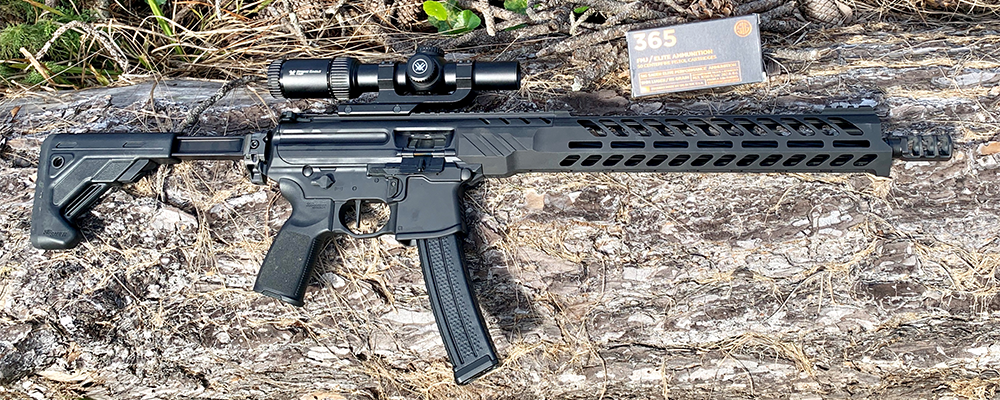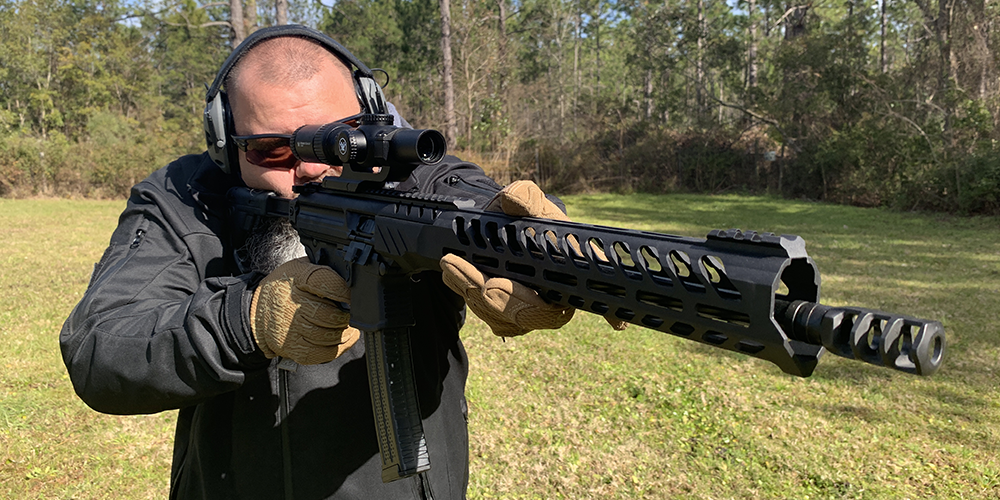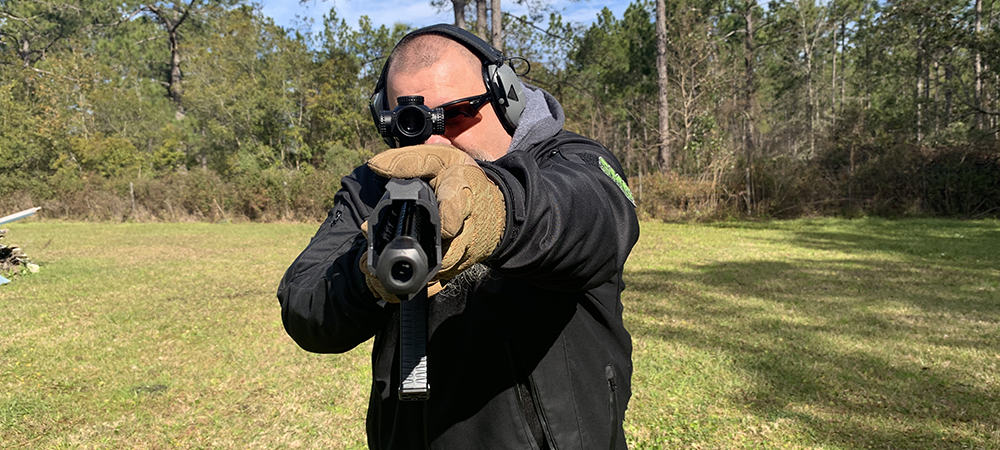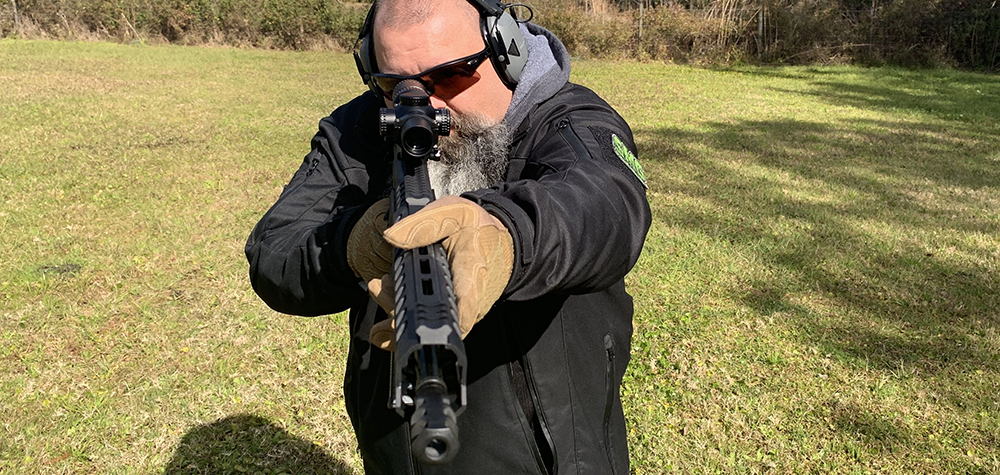
Last Updated on
The concept of a pistol caliber carbine isn’t new, Colt’s 9mm SMG, Uzi’s series of carbines and HK’s MP5 series have all been truly iconic firearms since the early 1970’s. These carbines were designed for military and law enforcement application in the hands of skilled operators. Later these firearms saw commercial success in semi-auto, 16-inch barreled civilian configurations mostly for collectors and recreational shooters. These guns retained their heavy, stiff and gritty triggers from their original full-auto design. What is relatively new is the huge trend of their appearance in competitions such as USPSA, IDPA and 3-Gun Nation. So much so, most competitive organizations created whole new pistol caliber specific divisions.

SIG Sauer MPX
In 2016, SIG SAUER developed the MPX for civilian, military and law enforcement without thought to competition. While it may resemble a common gas impinged AR-15, the SIG SAUER MPX was actually designed to be a gas piston operated successor to the HK MP5 platform. What resulted was an easy to handle rifle with a very small learning curve for the majority of shooters who were already well versed on the AR platform. With a few modifications, the most popular being from the weapon wizards over at Taran Tactical Innovations, the MPX was ready for the new pistol caliber carbine competitions. This gave the MPX shooters a distinct advantage over other rifles that operated on direct blowback operation both in reliability and recoil.

In 2018 during the NRA’s Annual Meeting (NRAAM), SIG SAUER announced the release of a new version of the MPX designed specifically to be competition ready right out of the box, the MPX Pistol Caliber Carbine or PCC for short. With new features like a single stage flat faced trigger from Timney Triggers and a highly effective muzzle break, this rifle grabbed the attention of a lot of pistol caliber carbine competition shooters, including SIG SAUER sponsored professional shooter, eight-time women’s world champion, Lena Miculek. When asked for comments about her new rifle, Lena responded: “The enhancements that SIG has incorporated into the MPX PCC will make a real difference to the professional shooter and be quickly realized in competition.” Since its debut, Lena has smashed her competition winning several matches with the SIG MPX PCC. Lena continued: “When it comes to my competition equipment, I want a rifle that’s reliable, accurate, and easy to shoot, and the SIG MPX PCC checks all the boxes.”
First Impressions
As a fan of the original MPX rifle and the MPX short barrel model, I was eager to try out the PCC for myself. I reached out to SIG and arranged to have a sample sent for testing. A few weeks later, I got a call from Preston at Legion Defense Industries confirming the rifle was ready for pick up along with a couple hundred rounds of SIG ammo to try out.
The SIG MPX PCC box contained the standard SIG propaganda, owner’s manual, rifle and one mag. (Trust me, I double checked, only one magazine.) As I removed the rifle and opened the action, oil literally dripped from it. To keep everything well lubed for shipping, the bolt was heavily coated with some sort of gun oil which managed to find its way everywhere through the rifle. I immediately broke the gun down and wiped it down to remove oil out of the barrel and excess from the action. I noticed the rifle had a true 16” barrel rather than the original MPX with the 14” barrel and 2” pinned flash hider to bring it to legal civilian length. For competition, every inch counts when the scores are tallied at the end of the run. Replacing the flash hider was a true 3 chamber brake which extended the reach of the rifle overall. I was eager to see if the extra length of the brake would be worth the addition when it came time to run the rifle for speed and accuracy.

The M-Lok rail was unique in how SIG mounted it to the receiver. When the upper and lower are separated, the rail easily slips forward and off the rifle for easy access to the barrel and barrel nut. The rail itself gave the rifle a sleek look and great overall feel when handling it. The only built in Picatinny rails were located on top in two spots. One section near the receiver and one at the muzzle end for mounting an optional front iron sight. The rest was smooth for an easy grip on the rifle. All four sides offered the spaces for mounting plenty of additional accessories such as lights or lasers. It should be noted the original MPX design had a quickly outdated key-mod rail. If anything, the SIG MPX PCC model brings the rifle more up to date.
One thing is for certain, the PCC is not your average AR-15 platform. The best way to describe it is if an AR-15 and an HK MP5 had a baby, it would be the SIG PCC. It feels like an AR-15, but loading it and later, on the range shooting it, it felt just like an MP5. As an owner of numerous AR platform rifles and an authentic HK MP5, I could tell even at first glance, the PCC offered the best of both worlds in one easy to use package.

MPX PCC SPECS
- Operating System: Gas Piston
- Caliber: 9mm Luger
- Overall Length: 35.25 in
- Barrel Length: 16 in
- Weight: 6.63 lbs.
- Trigger: Timney Triggers Flat Face
- Twist Rate: 1:10
- Magazine Type: Proprietary SIG SAUER MPX
Range Time
When I was ready to hit the range with SIG MPX PCC, I called up fellow Swanson Media Group writers, Clint Steele and Jerry Moody to meet the next day at the infamous private training grounds affectionately known as “The Swamp.”
Since the rifle did not ship with an optic, I decided to mount a scope similar to others I have seen many of the professionals use in competition. I went with a Strike Eagle 1-8×24 in a one-piece cantilever mount both made by Vortex Optics. This small scope offered a quick, easy to see illuminated reticle with a true 1x option that would work like any quality red dot and still allow the shooter to zoom in for “longer” shots out to 100 yards with clear vision and accuracy. (200 yards if you hold over the approximate height of two full size torso targets.) To speed up the transition from short range to long and back again, I included a MK Machining 3D printed throw lever. When switching magnification on the move, using a throw lever from MK Machining is like dropping a Hurst Speed shifter into a classic muscle car. It’s just going to make everything more efficient and faster!

Once Clint, Jerry and I got onto the range, fast seemed to be the name of the game. After quickly sighting in the Strike Eagle optic, we each took turns shooting at small 5-inch targets at popular competition distances. Two words quickly came to mind during these rounds for fire, FAST and ACCURATE! Everything about this rifle was built for speed. The side folding stock was noticeably “beefed up” from the original MPX design, giving the shooter a much better cheek weld to work with. The enhanced grip seemed to be recontoured for the PCC model to work better with the angle of the hand in relation to the stock when shooting. Ironically, the stock was the only thing slow about the rifle, as it took a good bit of pressure to lift and fold it from the stiff hinge attaching it to the lower receiver.
Loading the rifle on the move was made much easier with the addition of the flared magazine well. I did not remember the original design having this feature as it was very common for shooters to use an aftermarket Taran Tactical bolt on mag well to speed up loading. The 30-round magazine itself was just as easy to load as Clint pointed out while keeping everyone topped off between rounds of fire. Even the last four or five cartridges that always seem to be tough inserting into other hi-cap mags weren’t a chore with the MPX. Constructed of polymer rather than steel like the MP5 magazines, they are about an inch longer in length than their HK counterpart and a bit “beefier” as well. (No, they will not interchange). Retailing for $67 each direct through SIG SAUER, this may be a bit of a sticker shock until you realize the common market price of an HK MP5 magazine is about $80 each. This is one of the areas where you quickly realize the Pistol Caliber Carbine game is a “Big Kids” sport and you must pay to play.
While Clint and Jerry turn their turns on the rifle, I paid close attention to the three-chamber muzzle brake. I had noticed the rifle not only seemed to have very little recoil but also low muzzle rise. As the others shot, the rifle looked to remain very flat on target and allowed them to get very quick follow up shots. This experience was one of the few times I have had a clear answer to the question: “Do muzzle brakes really help?” The answer for the MPX PCC is clearly YES!

One mitigating factor in these quick follow up shots had to be the Timney Trigger. I applaud SIG SAUER in realizing one of the first things a competitive shooter will do to a rifle straight out of the box is replace the factory trigger. With Geissele, HyperFire and Timney being the “Big Three” of aftermarket competition triggers, I think SIG definitely made the best choice. Having extensively used triggers from all through companies, I am a huge fan of all three but with Timney’s shorter reset distance, it edges out the other two by literally a fraction of an inch.
Once Clint got comfortable with the rifle, the speed factor on the trigger started to really come into play. From distances varying from 5 – 15 yards, shots were one on top of another keeping a solid inch grouping with only a couple of 2-inch-wide flyers out of a 10-round string. I noticed when I shot, groups at close distances were about 2” low of bullseye and dead center at the 15-yard mark where the scope was zeroed, all holding close to a 1” to 1.5” groups. The faster I shot, the groupings only opened by an inch or two, still well inside the “A” zone of any competition target.
Jerry commented how smooth the gas piston system made the MPX PCC feel while shooting. Short impulses replaced the normal recoil of most direct blowback pistol caliber carbines on the market. While the brake did a great job of virtually eliminating the muzzle rise, the gas pistol operation greatly reduced excess gas exiting from the chamber into the shooters face and gave a cushion-like push into the shoulder during recoil. While gas piston systems do tend to cost more than gas-impingement regardless of the firearm, the reduction in felt recoil is where the money is well invested.
Due to some nerve damage in his right hand, Jerry has been successfully developing his skills as a newly left-handed shooter to the point of becoming an NRA instructor in the process. The fully ambidextrous controls of the PCC allow for both Jerry and Clint to run the rifle unobstructed from the left side. Having the charging handle, magazine release, safety and bolt release accessible and smoothly operational with either hand is a key “X-factor” in gaining needed speed where it counts to give the competitor more valuable time on the trigger making hits count.
Final Thoughts
Overall, I loved everything about the MPX PCC in the way I really like a Ferrari. Its an awesome piece of hardware with top notch features and handles like a dream. While I could fully appreciate the race car style features of the MPX PCC, to be fair, I am more of a 4×4 SUV type of guy. I personally don’t shoot competitions in favor of teaching / training with more “real world” application carbine courses. I would love to personally own a PCC one day just because it was a very smooth and accurate rifle but sadly, it would only be a very expensive plinker in my collection. Perhaps one day if either of my daughters decide to get into competitive shooting, I would gladly purchase one or possibly two to give them any advantage I could. With an already noticeable competitive spirit between the two of them inherited from their mother of course, I may need to start saving up now!
Personally, I like my 16” barrel rifles to be in rifle calibers such as 5.56 or 7.62 with my pistol carbines in 9mm luger and .45 to be a good bit shorter in barrel length. I really enjoy the short-barreled action version of the MPX built for close quarter action and running with a chest rig full of mags to keep the gun running hot. Due to the MPX PCC shipping with only one magazine, the chest rig wasn’t even an option during testing. Considering the price of the rifle (MSRP $1400) and extra mags ($67), SIG should really consider tossing in an extra magazine or two for the customer.
For new shooters, disabled shooters who may be sensitive to recoil and obviously competition shooters, the MPX PCC is perfect. The butter smooth action of the rifle combined with very user-friendly controls makes this rifle a literal game changer. Final verdict on this rifle after being “Swamp Tested and Swamp Reviewed” is coveted title of being “Swamp Approved”!




Leave a Reply